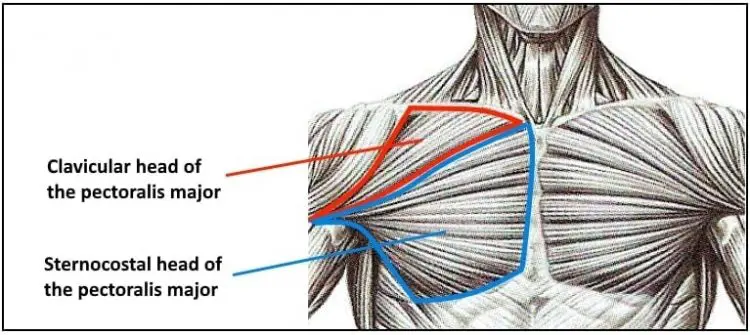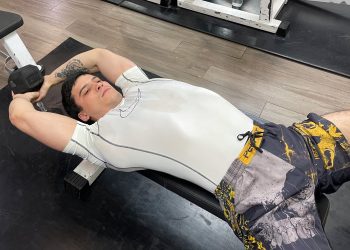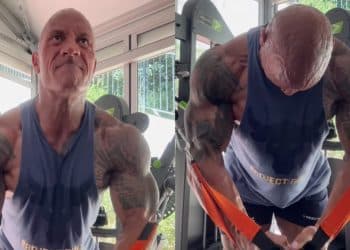Bench presses are arguably the most popular chest exercise on the planet, with push-ups coming in close behind. However, as effective as both these exercises undeniably are, you need more than the dynamic duo of bench presses and push-ups to build picture-perfect pecs.
To sculpt a balanced chest, you need to include exercises not just for your chest in general but your upper, lower, inner, and outer chest, too.
The lower chest can be notoriously hard to shape and build, but that’s where the lower chest cable fly comes in. This awesome exercise targets the lower pecs with laser-like proficiency.
We explain why and how to do this exercise and reveal the seven best variations and alternatives.
Lower Chest Cable Fly – Muscles Worked
The lower chest cable fly, also known as the high-to-low cable fly, is an isolation exercise involving movement at just one joint and a relatively small number of muscles. However, it’s great at what it does, which is hitting the lower pecs hard and precisely.
The muscles trained during lower chest cable flyes are:
Level Up Your Fitness: Join our 💪 strong community in Fitness Volt Newsletter. Get daily inspiration, expert-backed workouts, nutrition tips, the latest in strength sports, and the support you need to reach your goals. Subscribe for free!

Pectoralis major – known as your pecs for short, this is the largest chest muscle. Its main functions are horizontal flexion, adduction, and medial rotation of your shoulder joint.
While the pecs are a single muscle, they are made up of several groups of fibers, often referred to as heads.
- Clavicular head – this is your upper chest. It’s more active during incline movements, such as incline bench press and incline flyes.
- Sternal head – the most prominent pec head, this region forms the bulk of your chest mass. It’s most active during flat pec exercises, such as flat bench presses and horizontal pec flyes.
- Abdominal head – this is your lower chest and the focus of this article. Exercises like dips and decline dumbbell flys and presses emphasize this region of your pecs. However, cable exercises are often the best way to train the lower pecs as they allow you to keep your muscles under tension for longer.
Pectoralis minor – pec minor is a thin, flat muscle that lies underneath the pec major. It assists your pec major during most chest exercises and prevents your shoulders from lifting as you move them. Pec minor does not contribute much to chest size, but it’s still an important muscle. Pec minor often works with the lower pecs.
Anterior deltoids – it’s impossible to train your pecs without also hitting your deltoids, which are your major shoulder muscles. There are three sets of deltoid fibers or heads: posterior (rear), medial (middle), and anterior (front).
While all three deltoids are active during lower chest cable flyes, the anterior head is most active. Lower chest cable flyes are as much an anterior deltoid exercise as they are a pec shaper and builder.
So, now you know what muscles lower chest cable flyes work, it’s time to get down to the nitty-gritty of performing this excellent exercise.
How to Do the Lower Chest Cable Fly
Get more from lower chest cable flyes while keeping your risk of injury to a minimum by following these guidelines:
- Attach D-shaped handles to the high pulleys on a cable crossover machine. Ideally, they should be at head height or slightly above.
- Grab one handle in each hand and pull them down, so they’re close together and in front of your hips.
- Take a couple of steps forward and then adopt a split stance for balance. Place your preferred foot in front – it doesn’t matter which leg you lead with.
- Brace your abs and pack your shoulders back and down.
- Adjust your position so that the cable runs in line with your arms. Your elbows should be slightly bent but rigid.
- Open your arms and raise your hands out and back to around shoulder level. Get a good stretch in your chest but take care not to hyperextend your shoulders.
- Using your pecs, squeeze your arms back down and in. Push your shoulders forward in this position to increase lower pec activation.
- That’s one rep – keep going!
Pro tips: Increase lower pec activation by rotating your little fingers inward at the bottom of each rep. Pause in this position and contract your pecs as hard as possible to maximize muscle engagement.
This exercise works best when done for medium to high reps (8-20) with moderate to light weights. High-to-low cable flyes are unsuitable for low reps and heavy weights, as the load will pull you off balance. As such, this is an excellent endurance and hypertrophy exercise but less useful for building brute strength.
Lower Chest Cable Fly Benefits
Not sure if lower chest cable flyes deserve a place in your pec workouts? Weigh up these benefits and then decide.
A shoulder-friendly exercise – compared to bench presses and dips, the lower chest cable fly is very shoulder friendly. The long levers mean you can get a great workout from light to moderate weights, so there is less joint stress to contend with.
Also, the movement can easily be adjusted to accommodate any shoulder issues you might have. This is the perfect chest exercise for banged-up bodybuilders with achy shoulders.
Easy to learn – the lower chest cable fly is a pretty straightforward exercise that most people can learn in a few minutes. As such, it’s suitable for beginners, although more experienced exercises will benefit from it too.
A very safe exercise – with no bars or dumbbells to drop, you can do lower chest cable flyes to failure in complete safety. Also, you don’t need a spotter, so it’s ideal for solo lifters.
Perfect for high-intensity drop sets – because this is a machine exercise, you can rep out to failure, reduce the weight in a couple of seconds, and then rep out again to push your muscles even harder. You can’t do that with barbell or dumbbell exercises. Read more about drop sets here.
An effective exercise for the lower inner chest – if you want to hit your lower inner chest more precisely, this exercise will get the job done. Small adjustments in arm angle mean you can target your chest with sniper-like accuracy and build the lower pecs of your dreams.
Drawbacks
While lower chest cable flyes are a mostly beneficial exercise, there are also a few drawbacks to consider:
Not a good strength exercise – while doing lower chest cable flyes will make you stronger, their effect is somewhat limited because you can’t really do this exercise with heavy weights. If you want to develop Hulk-like strength, you need to do more bench pressing and spend less time on exercises like lower chest cable flyes.
You need a cable crossover machine to do them – while most gyms have cable crossover machines, they are sometimes busy or out of order. If you train at home, you may not have access to one at all.
So, if for any reason you don’t have a cable crossover machine to train with, you won’t be able to do this exercise. However, there are several alternatives that are just as effective – revealed in the next section.
Level Up Your Fitness: Join our 💪 strong community in Fitness Volt Newsletter. Get daily inspiration, expert-backed workouts, nutrition tips, the latest in strength sports, and the support you need to reach your goals. Subscribe for free!
7 Lower Chest Cable Fly Alternatives
Lower chest cable flyes are a highly effective lower pec exercise, but that doesn’t mean you need to do them all the time, or even at all. There are several variations and alternatives you can use to keep your lower chest workouts productive and interesting:
1. Decline cable flyes
The biggest drawback of lower chest cable flyes is that you need to use your abs to hold your body rigid to perform them correctly. As such, abs strength could limit exercise performance. Using a decline bench takes the stress off your abs so you can focus 100% on pumping your lower pecs.
Steps:
- Place an adjustable bench in the middle of a cable crossover machine. Set the backrest to a decline of 10-30 degrees.
- Attach D-shaped handles to the bottom pulleys.
- Holding a handle in each hand, lie on the bench with your head lowermost. Anchor your legs, so you don’t slide down the bench.
- Extend your arms and hold the handles above your chest. Bend your elbows slightly, but then keep them rigid. Your palms should be facing inward.
- Open your arms and lower the handles out and back until your feel a stretch in your chest.
- Squeeze your arms back together and repeat.
Muscles targeted:
- Primary: Lower pecs.
- Secondary: Anterior deltoids.
Benefits:
- Less stress on the abs than standing lower chest cable flyes.
- Harder to cheat as you cannot lean into the movement or use your legs.
- This an interesting exercise variation that’ll help prevent workout boredom.
Tips:
- Experiment with bench angles to discover your perfect lower-pec training sweet spot.
- Do 12-20 reps with a moderate to light weight for best results. Rest 60-90 seconds between sets.
- Try supersetting this exercise with push-ups for a quick but intense lower pec workout.
2. Decline dumbbell flyes
No cable crossover machine? Not a problem! You can also train your lower pecs with a trusty pair of dumbbells. While pec tension does tend to drop off at the top of each rep, this is a small price to pay for a convenient chest workout you can do at home.
Steps:
- Set your bench to a 10 to 30-degree decline. Lie on the bench with your head lowermost and a dumbbell in each hand.
- Press the weights up and hold them over your chest, palms facing inward. Bend your elbows slightly and then keep them rigid throughout.
- Pull your shoulders down and back, and brace your abs.
- Open your arms and lower the weights out and down to the sides to form a T-shape. Get a good stretch in your chest but take care not to hyperextend your shoulders.
- Squeeze your arms back together and repeat.
Muscles targeted:
- Primary: Lower pecs.
- Secondary: Anterior deltoids.
Benefits:
- A low-tech exercise that’s ideal for home use, and anytime you don’t have access to a crossover machine.
- Less shoulder strain than flat and incline dumbbells flyes.
- Suitable for developing shoulder mobility and stability as you build a bigger lower chest.
Tips:
- Perform 12-20 reps per set using light to moderate weights for best results.
- Do not go below 30 degrees decline, as doing so makes the exercise less effective.
- Twist your little fingers inward to increase inner and lower pectoral engagement.
3. Decline dumbbell bench press
While lower chest cable flyes are not ideal for heavy weights and building brute strength, decline dumbbell bench presses are. You can go pretty heavy with this exercise and just drop the weights out and down to the sides if you cannot complete a rep. However, for safety, they’re best done with a spotter nearby.
Steps:
- Holding a dumbbell in each hand, lie on your decline bench with your head lowermost. Hold the dumbbells over your chest with your arms straight and palms facing down your body. Pull your shoulders down and back, and brace your core.
- Bend your elbows and lower the dumbbells down and out to your shoulders. Keep your wrists straight.
- Push the dumbbells back up and in to complete your rep.
Muscles targeted:
- Primary: Lower pecs.
- Secondary: Anterior deltoids, triceps.
Benefits:
- A shoulder-friendly alternative to flat bench presses.
- An excellent exercise for lifting heavy weights and building strength AND muscle size.
- More comfortable for some people than barbell decline presses.
Tips:
- Do 6-10 reps with heavy to moderate weights.
- Use a full range of motion to maximize lower pec engagement; no half-repping!
- Try doing this exercise with an alternating arm action for variation.
4. Chest dips
There are two ways to do dips – with an upright torso to emphasize your triceps or by leaning forward to work your lower chest. Both exercises are great, but you should always do the version that hits the muscles you most want to train.
Steps:
- Use dipping bars that are wider than shoulder-width apart. The narrower your grip, the less low chest engagement there will be.
- Place your hands on the bars with your palms turned inward. Support your weight on straight arms.
- Bend your knees and push your legs and hips as far back as possible. The greater the angle, the more pec activation there will be.
- Bend your arms and descend as far as you can without hurting your shoulders. Get a good stretch in your lower pecs. Allow your upper arms and elbows to flare outward.
- Extend your elbows and push yourself upward, stopping just short of lockout to keep the tension on your pecs. Push inward as well as downward to maximize lower pec engagement.
- Descend and repeat.
Muscles targeted:
- Primary: Lower pecs.
- Secondary: Anterior deltoids, triceps.
Benefits:
- No equipment required – ideal for home exercisers and outdoor trainers.
- A good test of relative strength.
- A challenging exercise for experienced exercisers.
Tips:
- Increase workout intensity by using a weight vest or dipping belt.
- Descend as far as comfortable to maximize the stretch in your lower pecs and make the exercise even more effective.
- Take your sets to failure and then jump up and lower yourself under control for a couple of muscle-building negative reps.
5. Decline barbell bench press
If you want to hit your lower pecs with heavy weights, the decline barbell bench press is one of the best ways to do it. With only one weight to balance, you are perfectly set up to push heavy loads without being distracted by wandering dumbbells!
Steps:
- Lie on your decline bench with your head lowermost and your eyes directly beneath the racked barbell.
- Grip the bar with an overhand, slightly wider than shoulder-width grip. Pull your shoulders down and back and unrack the bar. Use a spotter to help you if you are using heavy weights.
- Bend your arms and lower the bar to your sternum. Touch your chest lightly, and do not bounce!
- Drive it back up to arm’s length and repeat.
Muscles targeted:
- Primary: Lower pecs.
- Secondary: Anterior deltoids, triceps.
Benefits:
- An excellent exercise for heavy training and building strength.
- More shoulder-friendly than flat and incline barbell bench presses.
- A widely available exercise – most gyms have a decline bench press station.
Tips:
- Do sets of 6-10 reps using a moderate to heavy load.
- Always do this exercise with a spotter in case you cannot complete a rep.
- Experiment with your grip width to find the perfect hand position for working your lower chest while minimizing shoulder joint stress.
6. Deficit push-ups
It may surprise you to learn that deficit push-ups are a fantastic lower pec exercise. If you take a sideways look at the humble push-up, you’ll see your body is in a declined position, not unlike a decline bench press. High-rep deficit decline push-ups are a great way to pump up your lower pecs at home.
Steps:
- Place push-up handles, yoga blocks, weight plates, or bricks on the floor slightly wider than shoulder-width apart.
- Squat down and place your hands on your blocks, bricks, etc.
- Walk your feet out and back, so your body is straight. Brace your abs and pull your shoulders down and back.
- Bend your arms and lower your chest toward the floor. Descend so your chest is slightly lower than your hands. Get a good stretch in your pecs.
- Push yourself back up, slightly protracting your shoulders at the top of each rep.
- Reset your shoulders and repeat.
Muscles targeted:
- Primary: Lower pecs.
- Secondary: Anterior deltoids, triceps.
Benefits:
- The perfect exercise for home trainers as no special equipment is required.
- A very shoulder-friendly lower pec exercise.
- A good exercise for beginners and intermediates.
Tips:
- Press your hands inward and backward to maximize pec engagement.
- Take each set to within a couple of reps of failure, even if that means doing 20+ reps per set.
- Rotate your elbows in toward your sides to increase shoulder stability and do more reps.
- Wear a weight vest to make this exercise more challenging. Do NOT raise your feet. Even though this loads more weight onto your hands, it puts you in a horizontal position, reducing lower pec recruitment.
7. Double dumbbell pullover
The dumbbell pullover is usually seen as a lat exercise, which it is! But, as well as working your lats, dumbbell pullovers also hit your lower chest. Using two dumbbells takes some of the stress off your hard-worked shoulder joints by allowing you to use a wider arm position and ensures that you’re working both sides of your body equally.
Steps:
- Lie on a flat bench with a dumbbell in each hand. Press the weights up and hold them over your shoulders, palms facing inward, hands shoulder-width apart.
- Bend your arms slightly but then keep them rigid. Brace your abs and pull your shoulders down and back.
- Lower the weights backward over your head. Try not to let them move inward or out. Go back until your upper arms are next to your ears.
- Pull the weights back up and over your chest, and then repeat.
Muscles targeted:
- Primary: Lower pecs.
- Secondary: Latissimus dorsi.
Benefits:
- A good exercise for shoulder mobility and lat flexibility.
- An effective isolation exercise for the lower pecs and lats.
- Hits the lower pecs from a very different direction to flyes and presses.
Tips:
- This exercise works best when done for medium to high reps with moderate to light weights, e.g., 8-20 per set.
- You can also do this exercise with a single dumbbell, EZ bar, or barbell.
- Use a decline bench to increase the effective range of motion and keep your muscles under tension for longer.
Frequently Asked Questions
Got a question about lower chest cable flyes or lower pec training in general? We’ve got the answers!
Are lower chest cable flyes a good exercise?
They sure are! Lower chest cable flyes are a safe, effective, and accessible exercise that hits your lower pecs with laser-like precision. If you like them and can do them, they deserve a place in your chest-sculpting workouts.
How often should I work my lower chest?
While some people get good results training their lower chests once per week, it’s usually best to work your lower pecs twice a week, e.g., Monday and Thursday. This will allow you to accumulate more training volume and use a wider variety of exercises than doing one lower chest workout per week.
If you are happy with your lower pec development, one workout per week will be fine. Otherwise, go for twice a week if your schedule allows.
What sets and reps are best for lower chest cable flyes?
Lower chest cable flyes work best when performed using light to medium weights and moderate to high reps. For most, this gives you a working rep range of 8-20 reps per set. Heavy weights and low reps are impractical because the load will probably pull you backward and off balance.
In terms of sets, anywhere from two to five will produce good results. If you feel like you need more than five sets, you are either stopping too soon before muscle failure or resting too long between sets.
Is there another way to do lower chest cable flyes if you don’t have a cable crossover machine?
You can replicate lower pec cable crossovers using resistance bands or a suspension trainer. Alternatively, you can hit your lower pecs with any of the pro-proven alternatives in this article.
Do I really need to train my lower pecs?
Only YOU know the answer to that question!
Some people get enough lower pec growth from flat bench presses and other standard chest exercises. However, other lifters need to train their lower pecs more directly to sculpt an aesthetically-pleasing upper body.
If you are unhappy with the shape and size of your lower pecs, you probably need to include lower chest exercises in your workouts. But, if your lower pecs are already popping, you can probably skip this group of exercises.
Which is best – compound or isolation exercises?
Because compound exercises allow you to lift heavy loads, they are arguably the best option for building muscle strength AND size. In contrast, isolation exercises work best when performed with lighter weights and higher reps, so they’re better for endurance and hypertrophy.
So, decide on what you are training for, and then choose the type of exercise that best matches your goals. Alternatively, you can use compound and isolation exercises to enjoy the benefits of both types of training.
Got a good lower pec workout?
Sure do! Use this workout to build and shape your lower pecs. Do it 1-2 times per week for the next month or so.
| # | Exercise | Sets | Reps |
| 1 | Lower chest cable fly | 3 sets | 12-15 reps |
| 2 | Chest dips | 3 sets | AMRAP |
| 3 | Decline dumbbell bench press | 2 sets | 6-10 reps |
| 4 | Double dumbbell pullover | 2 sets | 12-15 reps |
| 5 | Deficit push-ups | 1 sets | AMRAP |
Lower Chest Cable Fly – Wrapping Up
The lower chest or high-to-low cable fly is a great way to target the lower fibers of your pecs. It keeps the target muscles under constant tension, provides an intense mid-rep pec contraction, and also stretches your chest at the top of each rep. These are all vital ingredients for an awesome chest workout.
But, as good as this exercise clearly is, it’s not the only way to train your lower chest, and there are plenty of alternatives you can use.
Put the information in this article to good use, and you’ll soon be on your way to building a shelf-like lower chest to be proud of!
Interested in measuring your progress? Check out our strength standards for Bench Press, Push Ups, Dumbbell Pullover, and more.








